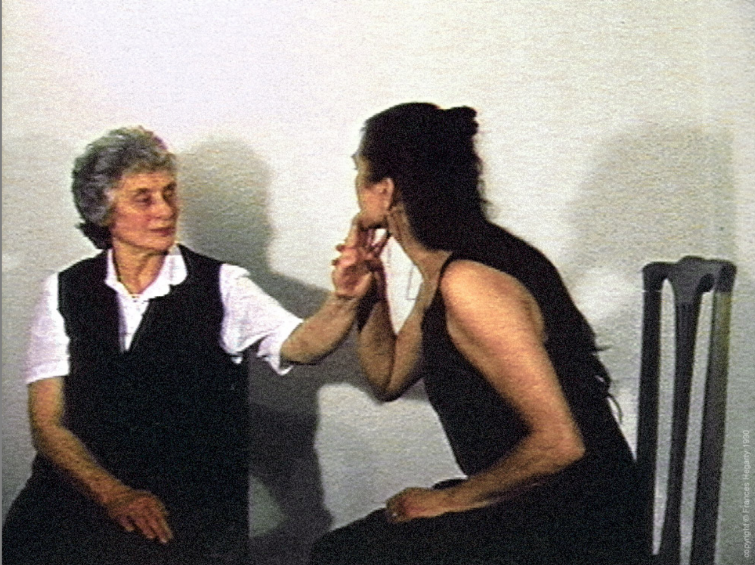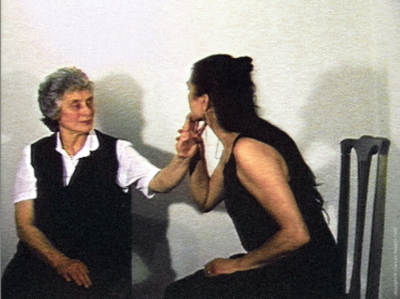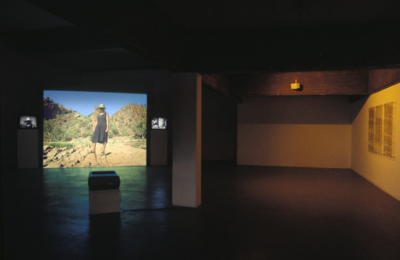Turas (Mothertongue), 1995 - restored 2022
The installation Turas (Mothertongue) uses a digital film projection as a room-within-the-gallery. The projected space is occupied by two women on straight-backed chairs: the artist, Frances Hegarty, and her mother. In a series of wordless gestural exchanges Hegarty expresses an aspiration to reconnect with a language held by her mother. After each exchange, she leaves her place in the scene, walking towards the viewer and blanking out the site of familial interaction.
Two loudspeakers on stands are located well within the viewer’s space, the sound-field emanating from them being emphatically separated from the on-screen performers, even as it might seem to be associated with their life-stories, or interior worlds. Fragments of speech rise out of the sounds two rivers, recorded at various locations between their estuary end and upland source. In particular, the artist is heard asking in her stilted Gaelic whether or not she could re-learn that language, her mother replying that this would certainly be possible.
The Gaelic language, and these particular rivers (the Foyle and Finn) are defining features of Hegarty’s Donegal home-place, with its history of emigration along the route of the rivers. Turas (Mothertongue) is concerned with the complexity of a mother-daughter relationship where the mother embodies the potential for reengagement with a language and culture seemingly at odds with generational change. In the work, the artist confronts the dilemma of exercising her agency as a contemporary artist whilst being deeply invested in just such a culture.
Turas (Mothertongue) is one of several works emerging from Hegarty’s wider ‘Turas’ project, begun in 1990. The project in all its iterations is part the artist’s interrogation of her own experience of the Irish diaspora, along with works such as Teanga (with Coiste Na mBan; ‘Available Resources’, Orchard Gallery, Derry, 1991) and Gold (1993).
Turas (Mothertongue) is a fully restored work edited on the template of the 1995 single-screen installation widely shown under the single-word title ‘Turas’. The restoration uses high-resolution, digitally-restored scans of the original super 8 film footage, shot in 1989. It features a remixed and remastered soundtrack completely rebuilt from recordings made in the same year, during the artist’s journey along the course of the Rivers Foyle and Finn.
Film, interviews and sound recordings made on the 1989 journey are the basis of Hegarty’s wider Turas project, from which multiple works have emerged, including a film following the artist’s performative actions along the course of the rivers.
Extracts from Hegarty’s own ‘Turas’ journal have been published, and outcomes of the project have been widely discussed by writers including Maeve Connolly (2018) Suzanna Chan (2015), Sheila Dickinson (2009), and Hilary Robinson (2000, 2003). See www.franceshegarty.com/commentary
More at: www.franceshegarty.com www.franceshegarty.com/art/turas.html
| Medium | Installation with digital film projection and stereo sound, for a prepared space |
| Dimensions | Duration: 4:28 min |
| Edition | Edition 1/3 |
| Item Number | ACQ.2023.FH.001.002 |
| Copyright |
Image © the artist For copyright information, please contact the IMMA Collections team: [email protected]. |
| Tags |



